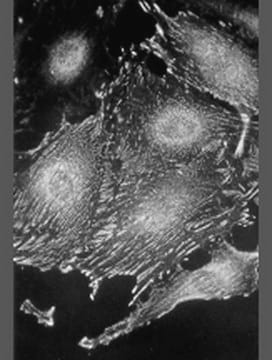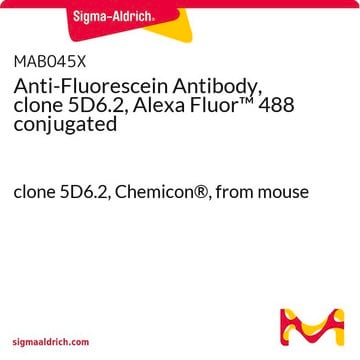11333089001
Roche
Anti-Digoxigenin
from sheep
Synonym(s):
anti-digoxigenin, digoxigenin
Sign Into View Organizational & Contract Pricing
All Photos(1)
About This Item
UNSPSC Code:
12352203
Recommended Products
biological source
sheep
Quality Level
conjugate
unconjugated
antibody form
purified immunoglobulin
antibody product type
primary antibodies
clone
polyclonal
form
lyophilized
packaging
pkg of 200 μg
manufacturer/tradename
Roche
isotype
IgG
storage temp.
2-8°C
General description
Digoxigenin is a hapten which is used in labeling of nucleic acids and in detection systems.
Probes labeled with digoxigenin has greater sensitivity equivalent to that of radioactive probes. It allows faster detection, is less hazardous and has an increased shelf life.
Specificity
The polyclonal antibody from sheep is specific to digoxigenin and digoxin and shows no cross-reactivity with other steroids, such as human estrogens and androgens.
Application
Anti-Digoxigenin has been used in DNA tethering. It has been used to attach DNA molecule to the glass surface of the flow cell.
Use Anti-Digoxigenin antibody for the detection of digoxigenin-labeled compounds using:
- ELISA
- Immunohistocytochemistry
- In situ hybridization
- Western blot
Biochem/physiol Actions
In the presence of Na+, Mg2+ and ATP, digoxigenin inhibits sodium pumps.
Preparation Note
Working concentration: Working concentration of antibody depends on application and substrate. The following concentrations should be taken as a guideline:
Working solution: For coating applications: PBS (phosphate buffered saline), pH 7.4
- ELISA: for coating: 2 to 4 μg/ml
- Immunohistocytochemistry: 0.5 to 2 μg/ml
- In situ hybridization: 0.2 to 0.4 μg/ml
- Western blot: 0.5 to 2 μg/ml
Working solution: For coating applications: PBS (phosphate buffered saline), pH 7.4
After immunization with digoxigenin, sheep IgG was purified by ion-exchange chromatography, and the specific IgG was isolated by immunosorption.
Reconstitution
Add 1 ml PBS to a final concentration of 200 μg/ml.
Analysis Note
No cross reactivity with other steroids, such as human estrogens e.g., estradiol or androgens e.g., testosterone.
Other Notes
For life science research only. Not for use in diagnostic procedures.
Not finding the right product?
Try our Product Selector Tool.
Signal Word
Warning
Hazard Statements
Precautionary Statements
Hazard Classifications
Skin Sens. 1
Storage Class Code
11 - Combustible Solids
WGK
WGK 3
Flash Point(F)
does not flash
Flash Point(C)
does not flash
Certificates of Analysis (COA)
Search for Certificates of Analysis (COA) by entering the products Lot/Batch Number. Lot and Batch Numbers can be found on a product’s label following the words ‘Lot’ or ‘Batch’.
Already Own This Product?
Find documentation for the products that you have recently purchased in the Document Library.
Customers Also Viewed
Affinity Labeling of a Sulfhydryl Group in the Cardiacglycoside Receptor Site of Na+/K+?ATPase by N?Hydroxysuccinimidyl Derivatives of Digoxigenin.
Antolovic R, et al.
European Journal of Biochemistry, 227(1?2), 61-67 (1995)
Chan Chen et al.
Aging, 12(14), 14490-14505 (2020-07-22)
Cardiac arrest (CA) is the leading cause of death around the world. Survivors after CA and cardiopulmonary resuscitation (CPR) develop moderate to severe cognitive impairment up to 60% at 3 months. Accumulating evidence demonstrated that long non-coding RNAs (lncRNAs) played
Pengyu Hao et al.
Proceedings of the National Academy of Sciences of the United States of America, 117(30), 17775-17784 (2020-07-17)
DNA mismatch repair (MMR), the guardian of the genome, commences when MutS identifies a mismatch and recruits MutL to nick the error-containing strand, allowing excision and DNA resynthesis. Dominant MMR models posit that after mismatch recognition, ATP converts MutS to
Electron paramagnetic resonance of a single NV nanodiamond attached to an individual biomolecule.
Teeling-Smith R M, et al.
Biophysical Journal, 110(9), 2044-2052 (2016)
Juliette Salvaing et al.
PloS one, 7(5), e38156-e38156 (2012-06-14)
In the mouse zygote, DNA methylation patterns are heavily modified, and differ between the maternal and paternal pronucleus. Demethylation of the paternal genome has been described as an active and replication-independent process, although the mechanisms responsible for it remain elusive.
Our team of scientists has experience in all areas of research including Life Science, Material Science, Chemical Synthesis, Chromatography, Analytical and many others.
Contact Technical Service







